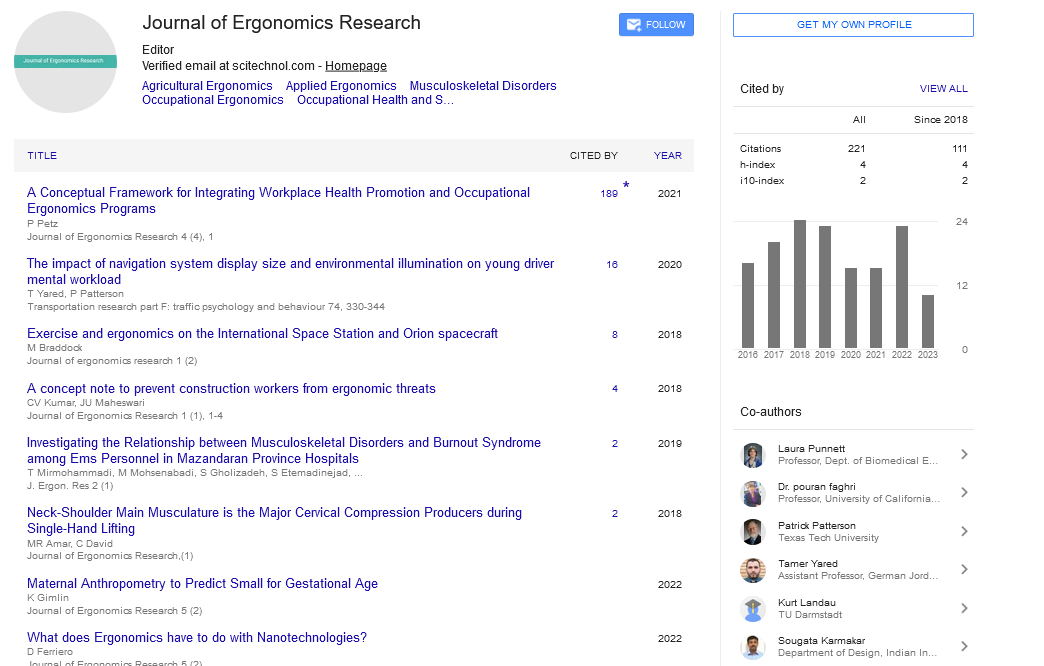Editorial, J Ergon Res Vol: 1 Issue: 1
Work-Related Musculoskeletal Symptoms and Job Factors among Milkers-Health in the Rural Environment
Claudilaine Caldas de Oliveira*
Department of Production Engineering, Federal University of Santa Catarina, Brazil
*Corresponding Author : Claudilaine Caldas de Oliveira
Department of Production Engineering, Federal University of Santa Catarina, Brazil
Tel: 44 35234647
E-mail: claudilainecaldas@gmail.com
Received: October 24, 2017 Accepted: November 06, 2017 Published: January 01, 2018
Citation: de Oliveira CC (2018) Work-Related Musculoskeletal Symptoms and Job Factors among Milkers-Health in the Rural Environment. J Ergon Res 1:1.
Abstract
Work in rural areas is considered an inherently risky activity due to both climatic and/or economic aspects. However, additional risk factors are present, such as hazards posed to the health and safety of rural workers resulting from inadequacy of their organization, which has revealed characteristics increasingly different from those of the urban work, especially in milk production. Milk production is a globally relevant activity that encompasses over 150 million rural properties, with approximately 750 out of 895 million workers directly or indirectly involved in this production.
Keywords: Musculoskeletal symptoms; Rural environment
Work in rural areas is considered an inherently risky activity due to both climatic and/or economic aspects. However, additional risk factors are present, such as hazards posed to the health and safety of rural workers resulting from inadequacy of their organization, which has revealed characteristics increasingly different from those of the urban work, especially in milk production [1]. Milk production is a globally relevant activity that encompasses over 150 million rural properties, with approximately 750 out of 895 million workers directly or indirectly involved in this production [2]. Another important aspect of this production branch is that approximately three-quarters of dairy farms have a predominantly family labor force [3]. Although the dairy-cattle industry has economic and social importance in the rural setting, it also presents a matter of concern, mainly in the milking and cattle-handling activities. In general, rural workers are directly responsible for their work activities. This is the case on dairy farms, where they milk and handle dairy cattle, thereby exposing their functions to risks, especially in ergonomic terms, and accidents [4]. Many studies in different countries have revealed a high prevalence of musculoskeletal symptoms among rural workers in dairy farming due to how activities are performed, involving elevated risk factors during the lifting and transport of heavy loads, adoption of awkward postures, and repetitive movements [5,6]. Because of the presence of risk factors for the onset of skeletal muscle diseases in dairy farming, it is essential to raise the awareness of milkers about the risks mainly those pertaining to ergonomics and accidents during the execution of their tasks. The milking system of dairy farms typically comprises the following tasks: i) gathering the cows, ii) tying their hind legs and tail, iii) dispensing the first jets of milk, iv) cleaning the cows’ udder, v) pre-dipping, vi) attaching the milking cluster to the cows’ udder, vii) observing the milk flow, viii) detaching the milking cluster, ix) post-dipping, x) feeding the calves, xi) feeding calves and cows, and xii) cleaning the milking cluster and the milking parlor. Research shows that although further investigations are needed, the milking activity is considered intense and inflexible with regard to working hours, considering that milkers wake up very early to do the milking, besides the heavy daily workload (no weekends, days off, or holidays). These workers do not have leisure and/or gymnastic activities and are geared practically entirely towards work. Despite the above-described evidence, little information is available on the prevalence or risk factors for the emergence of musculoskeletal diseases among rural dairy workers by contrast, recent investigations aimed at assessing the prevalence of such diseases and identifying risk factors for the spine and upper limbs among dairy rural workers have revealed risks that have drawn the attention of researchers [4]. It was found that jobs in dairy farming are in general inadequate, constantly demanding the squatting position; several side deviations (torsion/flexion) of the spine such as that of the cervical region of the milker, mainly as he or she visualizes the udder of the animal; and awkward postures that entail a great deal of effort. Additionally, co-workers may contribute to the development of musculoskeletal injuries amongst themselves. Therefore, in the dairy-farming segment, ergonomics has stood out as extremely useful because of its contributions to both enhancing the work organization and protecting the workers’ health, from the overload perspective, generating significant knowledge to improve the human-work conditions and speed up processes at work. Ergonomic recommendations are thus required to reduce these awkward postures of milkers and consequently improve their quality of life at work.
References
- Oliveira CC, Xavier AP, Ulbricht L, Moro AR, Belinelli MM (2016) Health in rural environment: an evaluation of postural workers in milking. International Symposium on Work in Agriculture. Maringá, Paraná, Brazil, pp: 1-6.
- Hostiou N, Cialdella N, Vazquez V, Müller AG, Le Gal PY (2015) Work organization on smallholder dairy farms: A process unique to each farm. Trop Anim Health Prod 47: 1271-1278.
- Hemme T, Otte J (2010) Status and prospects for smallholder milk production. A global perspective. FAO-PPLFP, Rome, Italy.
- Oliveira CC, Ulbricht L, Moro AR (2017) Avaliação da exposição dos trabalhadores da pecuária leiteira aos riscos ocupacionais. Revista uniandrade 18: 1-15.
- Oliveira CC, Merino ED, Moro AR, Ulbricht L (2013) Determination of the lifting index (LI) of NIOSH equation in milking manual activity in rural properties in COMCAM region, Brazil 34: 2-4.
- Oliveira CC, Moro AR, Ulbricht L, Belinelli M, Souza GF, et al. (2017) Ergonomic evaluation of workload by milk production a bibliometric analysis. Ann Agric Environ Med 24: 376-382.
 Spanish
Spanish  Chinese
Chinese  Russian
Russian  German
German  French
French  Japanese
Japanese  Portuguese
Portuguese  Hindi
Hindi 